| Description |
Erlotinib hydrochloride inhibits purified EGFR kinase with an IC50 of 2 nM.
|
| Related Catalog |
|
| Target |
EGFR:2 nM (IC50)
|
| In Vitro |
Erlotinib (CP-358,774) Hydrochloride is also a potent inhibitor of the recombinant intracellular (kinase) domain of the EGFR, with an IC50 of 1 nM. The proliferation of DiFi cells is strongly inhibited by Erlotinib with an IC50 of 100 nM for an 8-day proliferation assay[1]. The combination of B-DIM and Erlotinib (2 μM) results in a significant inhibition of colony formation in BxPC-3 cells when compared with either agent alone. The combination of B-DIM and Erlotinib (2 μM) results in a significant induction of apoptosis only in BxPC-3 cells when compare with the apoptotic effect of either agent alone[2].
|
| In Vivo |
There is a 1.49-fold statistically significant difference between AUC0-inf after p.o. administration of Erlotinib (5 mg/kg) comparing Bcrp1/Mdr1a/1b-/- and WT mice (7,419±1,720 versus 4,957±1,735 ng*h/mL respectively, P=0.01)[3]. The administration of Erlotinib (10 mg/kg/day, or 20 mg/kg/day) to Bleomycin (BLM)-treated rats shows no exacerbation of lung injuries in indices such as macroscopic findings, lung weights, histopathological scores (lung lesion density and lung fibrosis score), and pulmonary hydroxyproline (HyP) level. The result suggests that Erlotinib does not have any exacerbating effects on lung injuries induced by BLM in rats[4].
|
| Kinase Assay |
The kinase reaction is performed in 50 μL of 50 mM HEPES (pH 7.3), containing 125 mM NaCl, 24 mM MgCl2, 0.1 mM Na3VO4, 20 μM ATP, 1.6 μg/mL EGF, and 15 ng of EGFR, affinity purified from A431 cell membranes. The compound in DMSO is added to give a final DMSO concentration of 2.5%. Phosphorylation is initiated by addition of ATP and proceeded for 8 mm at room temperature, with constant shaking. The kinase reaction is terminated by aspiration of the reaction mixture and is washed 4 times with wash buffer. Phosphorylated PGT is measured by 25 mim of incubation with 50 μL per well HRP-conjugated PY54 antiphosphotyrosine antibody, diluted to 0.2 μg/mL in blocking buffer (3% BSA and 0.05% Tween 20 in PBS). Antibody is removed by aspiration, and the plate is washed 4 times with wash buffer. The colonmetric signal is developed by addition of TMB Microwell Peroxidase Substrate, 50 μL per well, and stopped by the addition of 0.09 M sulfuric acid, 50μL per well. Phosphotyrosine is estimated by measurement of absorbance at 450 nm. The signal for controls is typically 0.6-1.2 absorbance units, with essentially no back ground in wells without AlP, EGFR, or POT and is proportional to the time of incubation for 10 mm[1].
|
| Cell Assay |
To test the viability of cells treated with B-DIM, Erlotinib, or the combination, BxPC-3 and MIAPaCa cells are plated (3,000-5,000 per well) in a 96-well plate and incubated overnight at 37°C. A range of concentrations for both B-DIM (10-50 µM) and Erlotinib (1-5 µM) is initially tested. Based on the initial results, the concentration of B-DIM (20 µM) and Erlotinib (2 µM) are chosen for all assays. The effects of B-DIM (20 µM), Erlotinib (2 µM), and the combination on BxPC-3 and MIAPaCa cells are determined by the standard MTT assay after 72 h and is repeated three times. The color intensity is measured by a Tecan microplate fluorometer at 595 nm. DMSO-treated cells are considered to be the untreated control and assigned a value of 100%. In addition to the above assay, we have also done clonogenic assay for assessing the effects of treatment[2].
|
| Animal Admin |
Mice[3] Bcrp1/Mdr1a/1b-/- and WT mice are treated p.o. or i.p. with 5 mg/kg Erlotinib. The i.p. administration is chosen assuming good drug absorption and complete bioavailability. Sampling is done from the tip of the lateral tail vein in three series. During the first series, whole blood samples are collected at 15 min and 0.5, 1.5, 5, and 10 h after injection. Based on the results of this initial group, the sampling times of the two subsequent series are adapted to 5 and 15 min and 0.5, 1.5, 4, and 8 h after injection. After collection, the blood samples are immediately centrifuged and plasma is stored at -20°C until high-performance liquid chromatographic analysis took place. Rats[4] Seven-week-old male Crl:CD (SD) rats (244-297 g) are used. The animals are treated with Erlotinib Hydrochloride (10 mg/kg and 20 mg/kg) orally by gavage.
|
| References |
[1]. Moyer JD, et al. Induction of apoptosis and cell cycle arrest by CP-358,774, an inhibitor of epidermal growth factor receptor tyrosine kinase. Cancer Res. 1997 Nov 1;57(21):4838-48. [2]. Ali S, et al. Apoptosis-inducing effect of erlotinib is potentiated by 3,3'-diindolylmethane in vitro and in vivo using an orthotopic model of pancreatic cancer. Mol Cancer Ther, 2008, 7(6), 1708-1719. [3]. Marchetti S, et al. Effect of the ATP-binding cassette drug transporters ABCB1, ABCG2, and ABCC2 on erlotinib hydrochloride (Tarceva) disposition in in vitro and in vivo pharmacokinetic studies employing Bcrp1-/-/Mdr1a/1b-/- (triple-knockout) and wild-typ [4]. Adachi K, et al. Effects of erlotinib on lung injury induced by intratracheal administration of bleomycin (BLM) in rats. J Toxicol Sci. 2010 Aug;35(4):503-14.
|

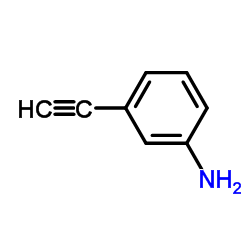 CAS#:54060-30-9
CAS#:54060-30-9 CAS#:183321-74-6
CAS#:183321-74-6![3-butyn-2-ol, 4-[3-[[6,7-bis(2-methoxyethoxy)-4-quinazolinyl]amine]phenyl]-2-methyl, hydrochloride Structure](https://image.chemsrc.com/caspic/127/299912-59-7.png) CAS#:299912-59-7
CAS#:299912-59-7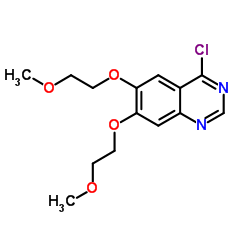 CAS#:183322-18-1
CAS#:183322-18-1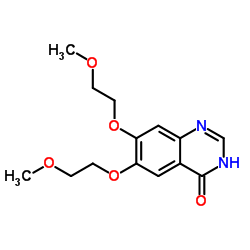 CAS#:179688-29-0
CAS#:179688-29-0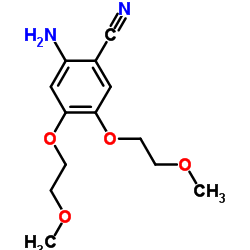 CAS#:950596-58-4
CAS#:950596-58-4 CAS#:122-51-0
CAS#:122-51-0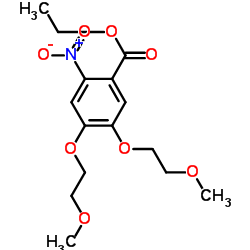 CAS#:179688-26-7
CAS#:179688-26-7